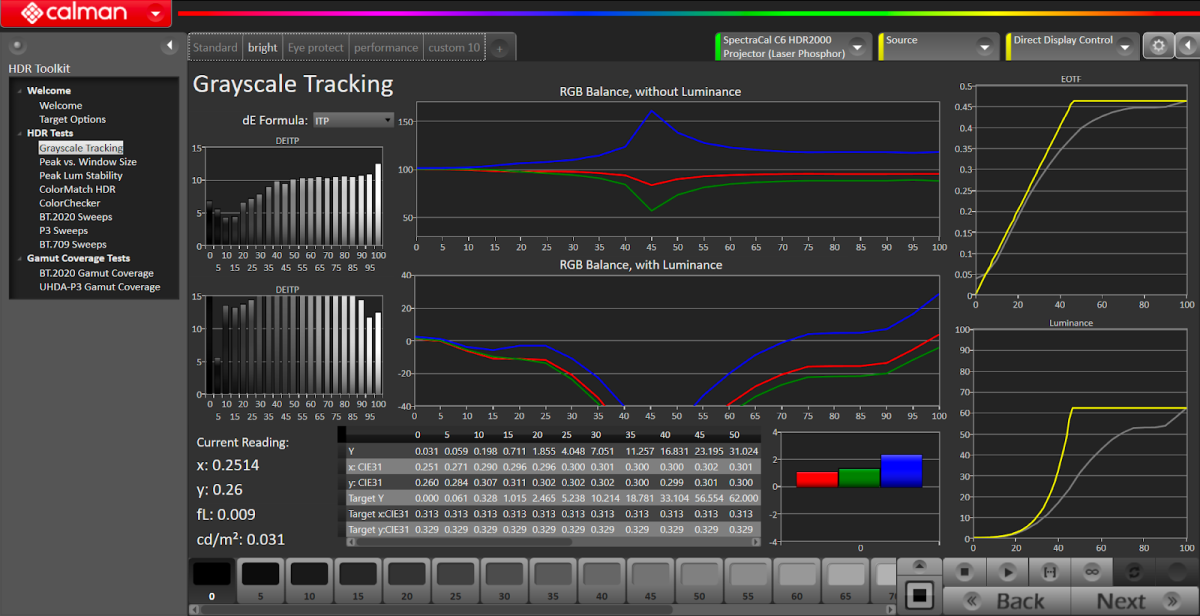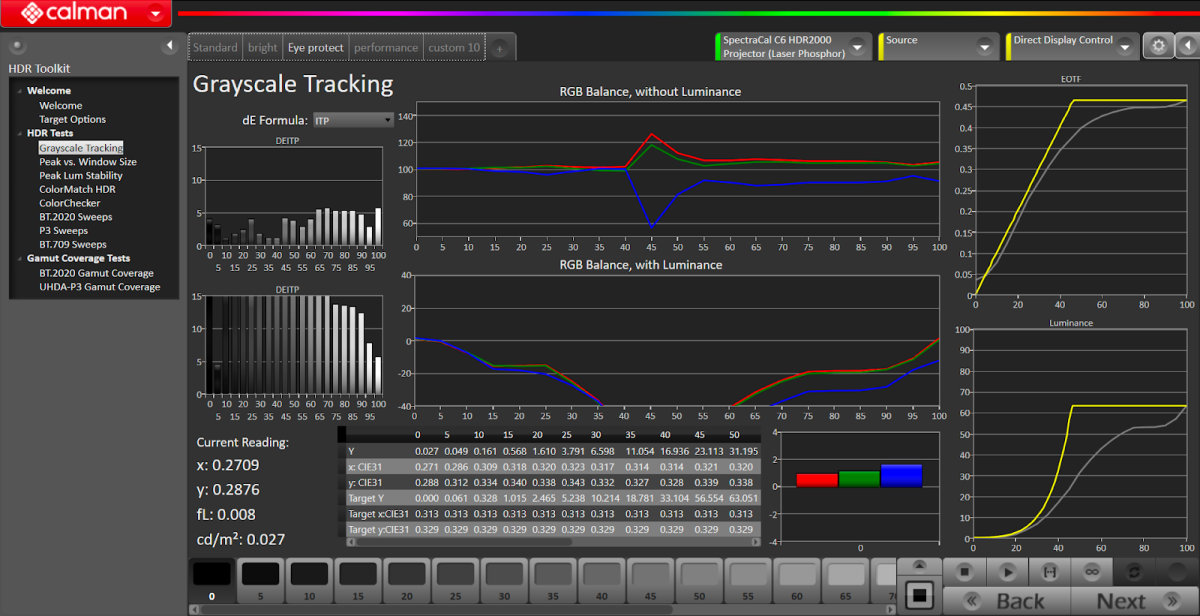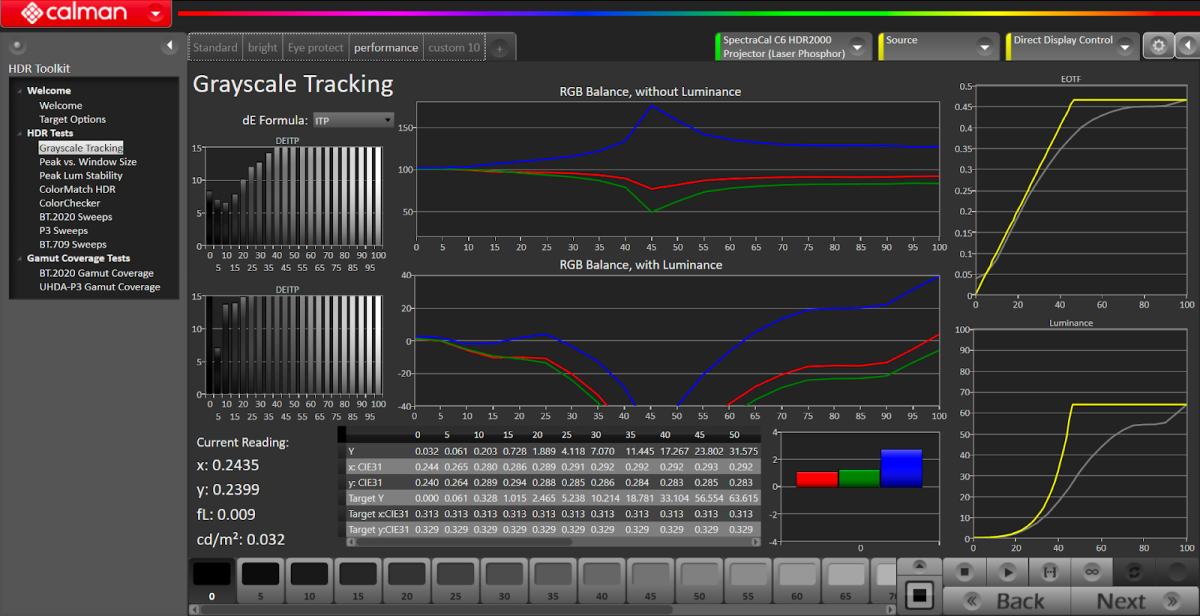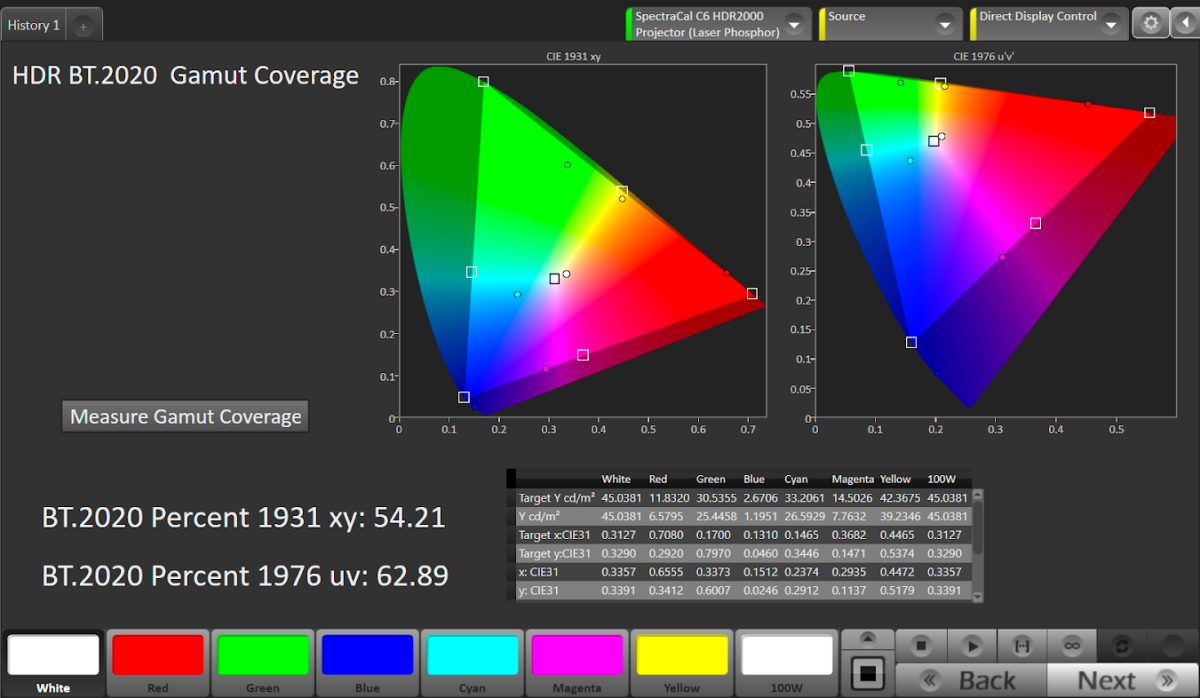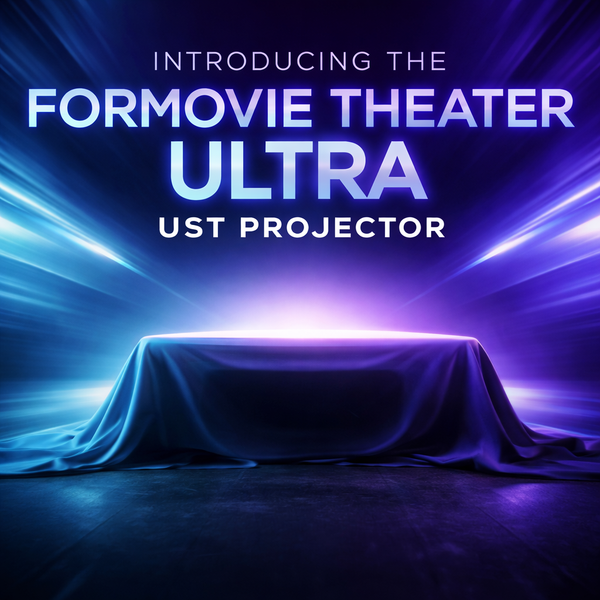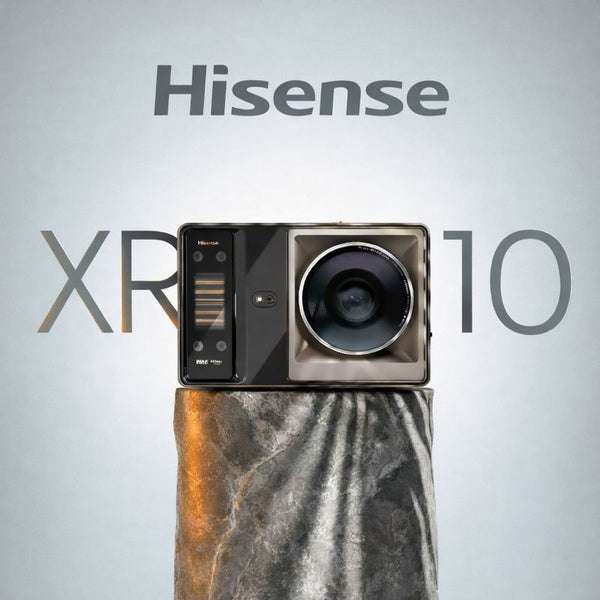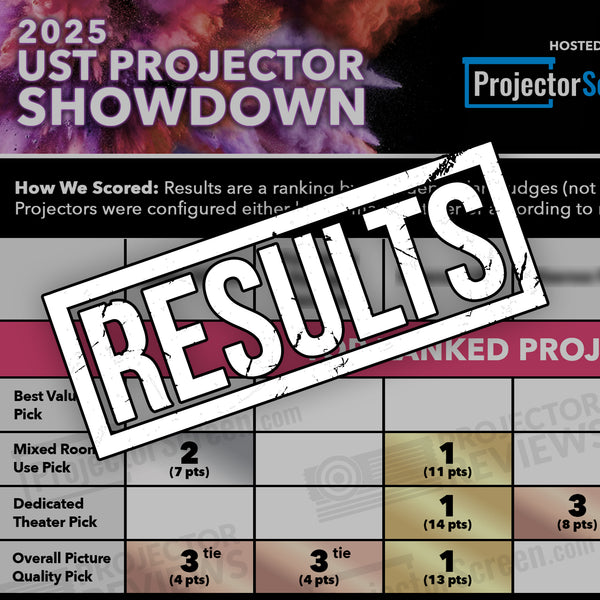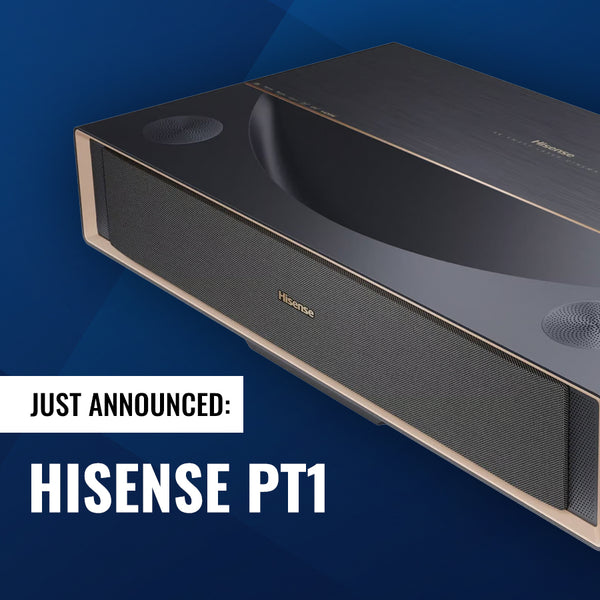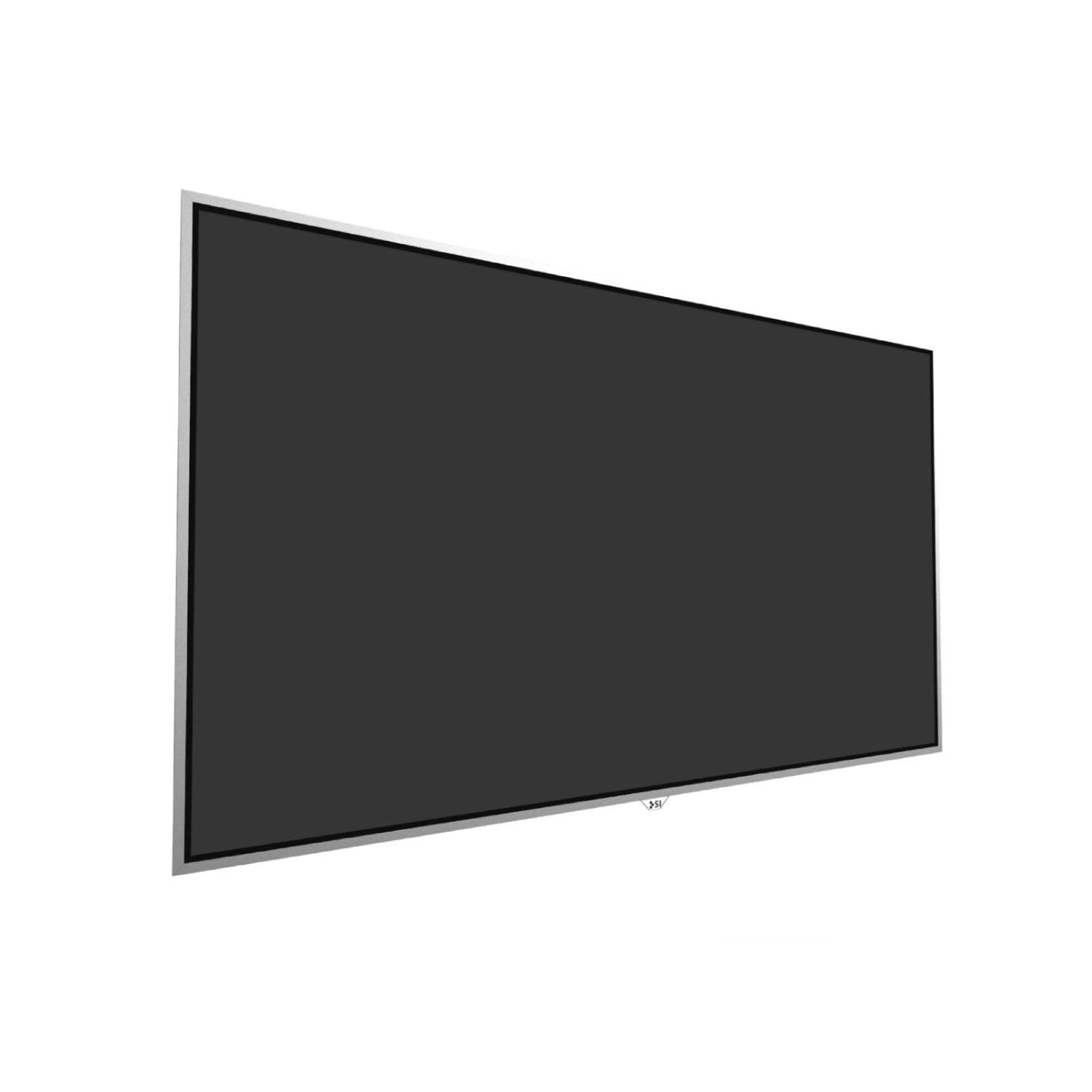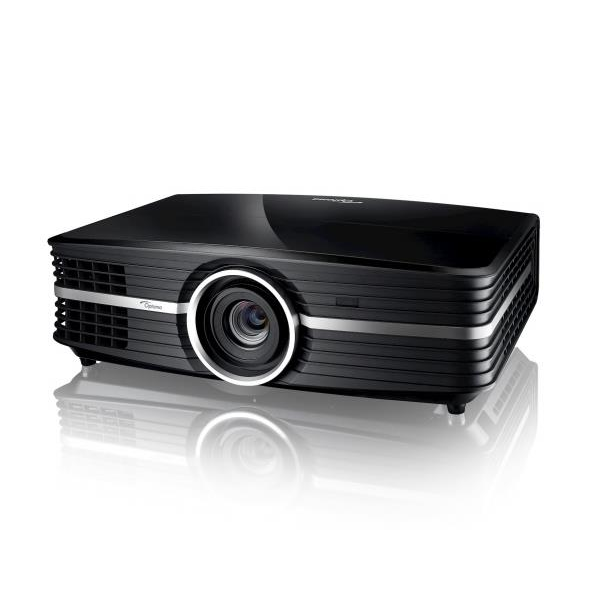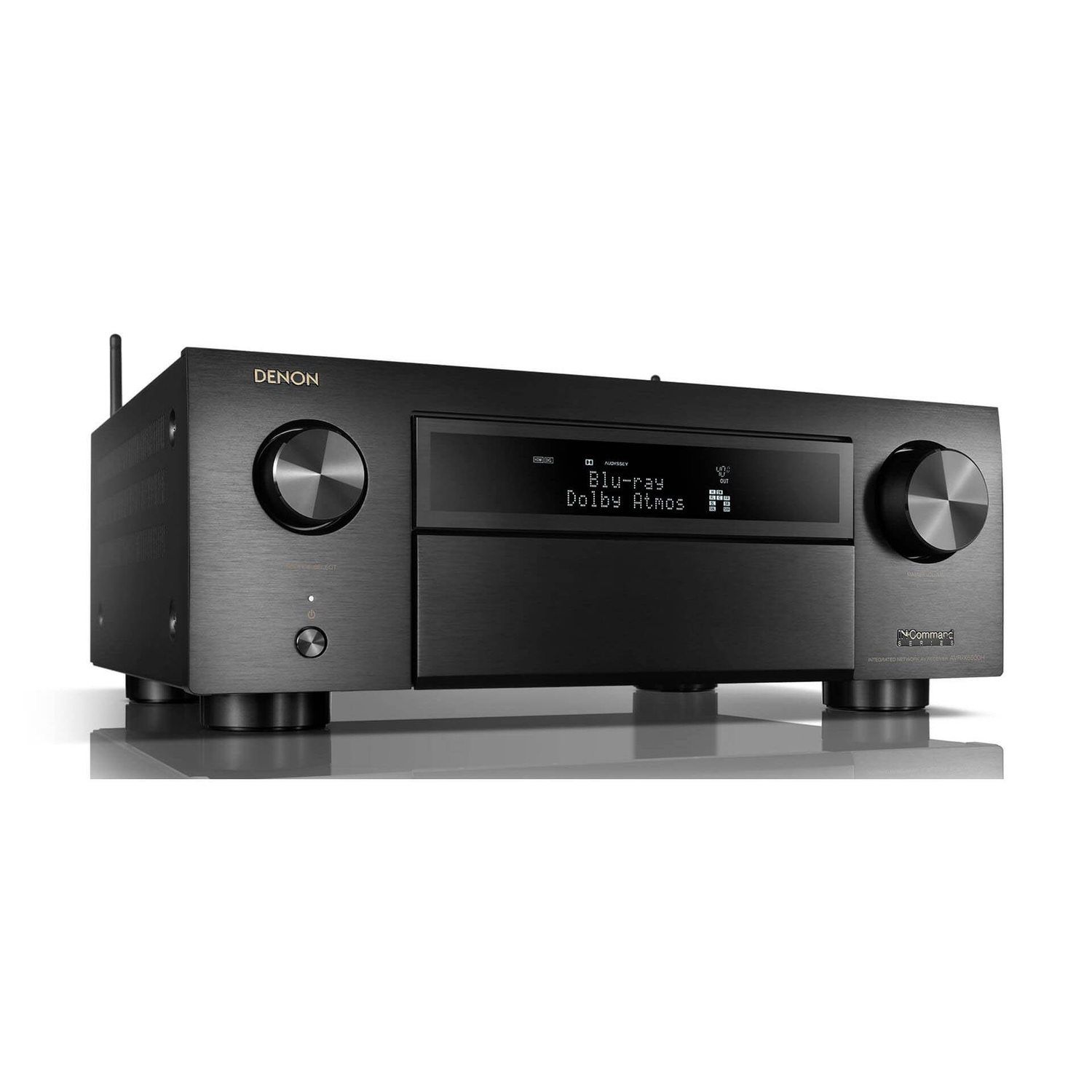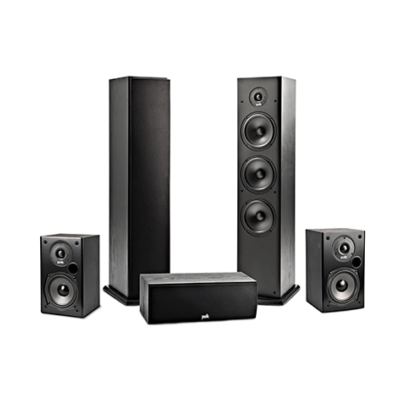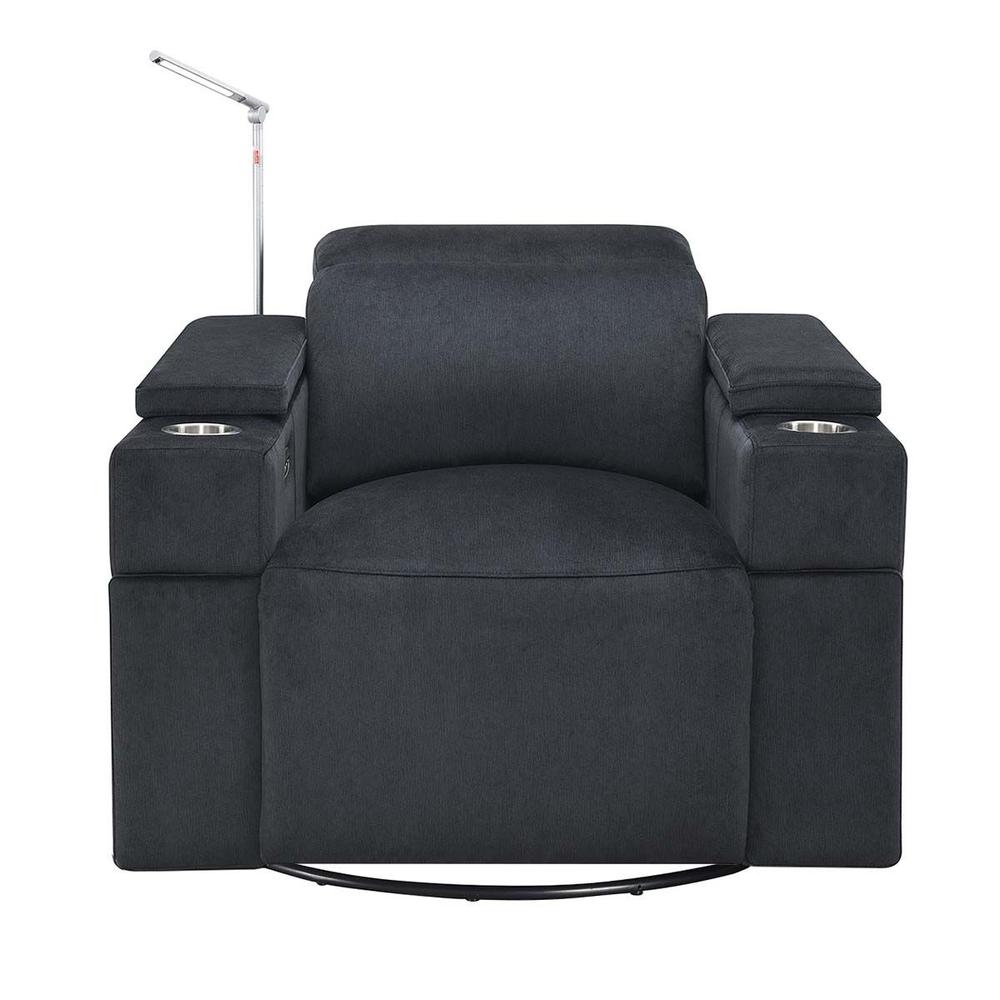XGIMI Aura Ultra Short Throw Projector Review

- Detailed, clean, sharp image. It has a more celluloid and cinematic image not seen in other true RGB USTs that can show a more cartoon-like image color.
- Decent White Balance when limited RGB settings adjusted
- HDR performance is pretty good and follows the PQ curve with a few “quirks”
- SDR color sweeps track fairly well (sans blue, which also messes cyan) given its non-existent CMS
- Contrast is better than most other DLP and UST projectors at around 2,200:1, but not at the top tier with others like Formovie Theater (DLP) and Epson LS800 (3LCD) which can reach into the mid 3,000’s to 1.
- More elegant and durable remote than most other cheap plastic, typical Android streaming types
- Decent gaming mode and lag in the low 40’s
- Great bang for your buck
- Limited amount of calibration controls to dial in image to reference
- No one mode is really best to use as a baseline for accurate D65. Only Custom Mode has any standard adjustment settings available
- Colors are oversaturated with no CMS to fix. Color has a weird hue that is hard to pinpoint
- Color gamut capability should be larger, as most other brands now have true RGB Laser designs supporting full BT.2020 color gamut.
- No dedicated Input button on remote, so have to go into menus to do this
- Only ARC HDMI Audio support. No eARC.
Features
The XGIMI Aura uses the standard single blue laser light source combined with a yellow-phosphor wheel paired with a color wheel, causing the Aura to not completely cover the whole DCI-P3 color gamut which is used in HDR content. Their specs say it is at about 80% of DCI-P3 and their BT.709 gamut tops out at 90% coverage. So the Aura does support HDR, but it won’t completely show the wider color gamut of HDR.
The Aura is rated at 2,400 ANSI lumens and the laser has a 25,000 hours of life. This projector supports the HDR10 and HLG HDR formats. It utilizes the .47" DLP DMD chip, with XPR pixel shifting technology to get the on screen image to 4K. It has a 0.233:1 throw ratio, putting it in line with most other USTs as far as the distances needed from the wall. The Aura has adjustable feet, two in front and two in the back for properly aligning the projector to the screen. It is also able to be mounted to the ceiling, but be careful if using an ambient light rejecting screen (ALR), since it would have to be flipped to do its job properly in this configuration, which also brings in other possible issues and factors that you should consider, such as making the ceiling lighting in the reflected light path coming from the screen.
The underlying operating system, like a lot of other recent USTs, is based on Android, this time version 10.0. This means that setup is easy if you have an Android phone so you can use it with your Google account. You just ask Google Assistant to set up the new device and then you confirm it with the code that shows up on screen. Once you do this, it automatically finishes setup, even by connecting to your home’s Wi-Fi, if you are connected to it on your phone!
The Aura UST Projector has most of the needed and popular streaming apps included, such as Amazon Prime, Hulu, YouTube, Vudu and even Netflix. Unfortunately even though the Netflix app is there, it doesn't really work, just like on the other projectors that run AndroidTV. When you try to log in you get an error message saying it is not usable with your account. Although since it has Chromecast capabilities built in, the way around this is to cast Netflix to it from another Chrome device. With these projectors, we always say to get your favorite separate streamer box or stick to get Netflix and all the other apps you want, many times in better quality. Also, since the Aura doesn’t have eARC to pass Dolby Atmos to your separate audio system, using this external box should also offer a better listening experience.
We really like the look of the Aura. It features a more up to date style with its curved top on its black and gray body. It weighs about 25lbs and its measurements are 23.9” x 15.8” x 5.5”.

Excellent Ways to Stay Connected
With a wide array of connection options, including 3 HDMI, 3 USB, 1 headphone, dual band 2.4/5G WiFi, and Bluetooth 5.0, AURA is ready for anything.6 Elevate your gaming via our Game Mode, music, and smartphone content easily.

Remote Control
The Xgimi Aura’s remote has most of the buttons you should need for basic controlling of the projector. It has your typical POWER, SETTINGS, Circular D-PAD, SELECT/ENTER, BACK, MENU, HOME, VOLUME -/+ and seeing as this is Android based, the ubiquitous “Google Assistant” button. Curious to note is that they offer a dedicate FOCUS button for accomplishing focusing of the projector, which you only really do one time during initial installation, but they don’t offer a dedicated INPUT button, which you’d use many times, even per session, to switch to the various pieces of equipment you may have attached such as a streaming device, Blu-ray player, cable/satellite box, game system, etc.
The remote is made of a nice brushed aluminum style with black plastic accents in the indented button area at the top half of the remote. It has a good feel in the hand with some weight to give it a more upscale feel in the hand.
Audio
The Xgimi Aura features a Harman Kardon sound system. It is not your typical TV’s sound system with tinny high and mid range with no bass to speak of. The Aura features two tweeters and two woofers at 15W each to deliver crisp highs, dynamic midranges, and ample bass. It is a more rich, room-filling audio experience that fills your room and ears with deep individual sounds, allowing you to hear and feel more detail and dimensionality.
Measurements
Grayscale
Brightness
Peak Center Brightness in Performance (Brightest) Mode
(Uncalibrated, In Lumens)
Movie Mode |
Football Mode |
Office Mode |
Game Mode |
Custom Mode |
|---|---|---|---|---|
2347 |
2344 |
1499 |
2348 |
1524 |
Contrast Ratio
On/Off (HDR, All Enhancements Off)
Brightest Laser/Office Mode |
Brightest Laser/Game Mode |
Brightest Laser/Movie Mode |
Brightest Laser/Football Mode |
Brightest Laser/Custom Mode |
Custom Laser 10/Custom Mode (Used for HDR Calibration) |
Eye Protection Laser/Movie Mode |
|---|---|---|---|---|---|---|
1,409:1 |
2,220:1 |
2,218:1 |
2,225:1 |
2,000:1 |
2,113:1 |
2,185:1 |
Color Gamut
Gaming
As with other displays and projectors, their gaming modes almost always don’t include any picture modes and processing so the Lag times can be the best they can possibly be. This is no different with the Aura, as expected. XGimi decided at the factory what and how it should work for gaming and they seemed to do a decent job of it, although there are no controls to change anything so you have to take what you get. I am no gamer, so I had my son hook up his XBox. He said it didn’t appear to have any issues really when playing various games, but did seem a little slower reaction time on first person shooters than what his Hisense flat panel he uses for gaming normally gives him. He’s been an invaluable resource for me when it comes to testing these USTs for gaming, haha!
The image the Aura renders with gaming appears to be similar to what you see with movies and TV, with good cinematic details and sharpness across the screen but also with the same color and picture tone results.
- Input Lag
- Reported to be in the 40-45ms range
Gamma
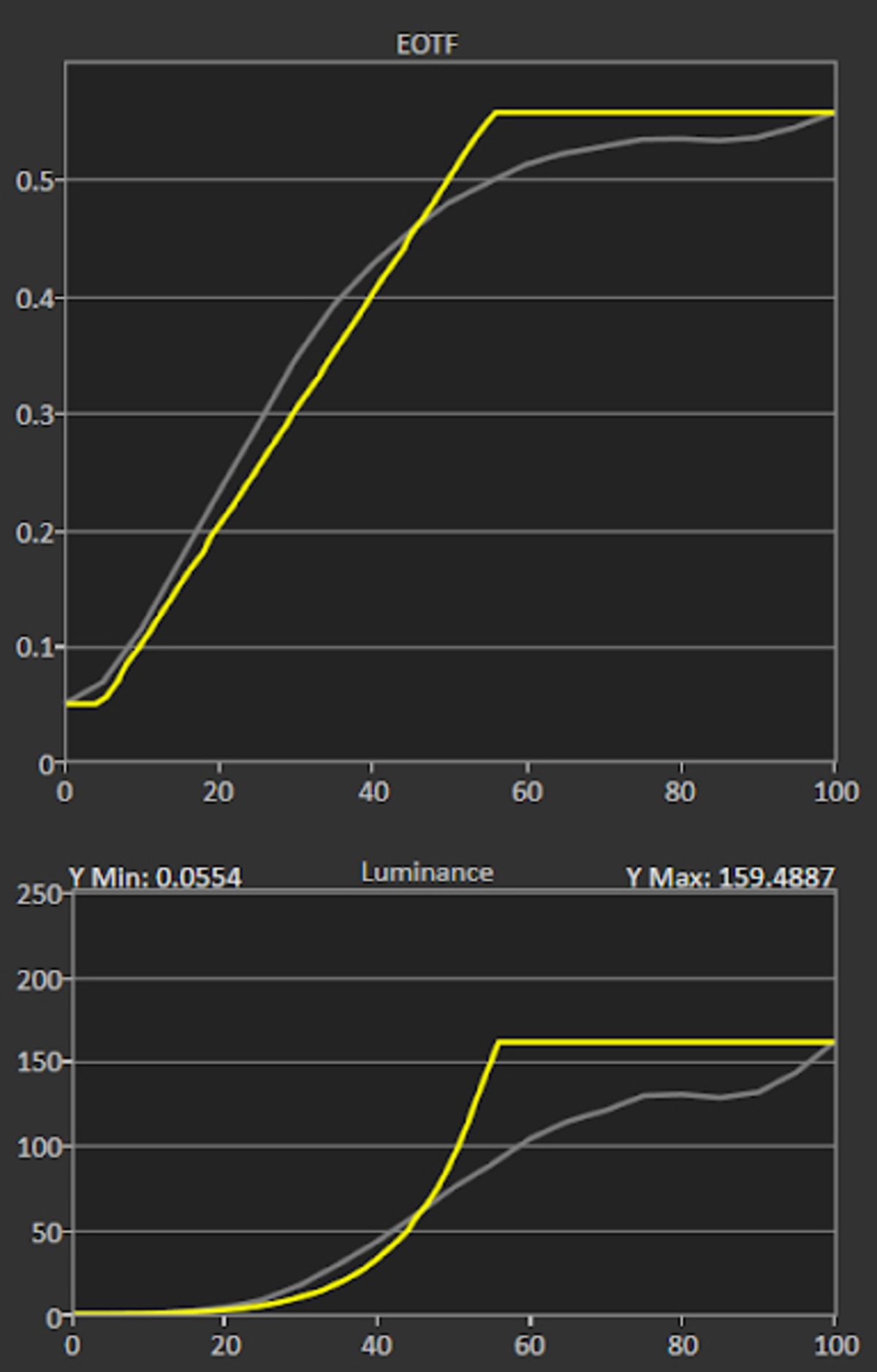
Out-of-the-Box
HDR PQ
The HDR PQ shows the image is slightly brighter and boosted in the midranges and then it rolls off as normal with a slight bump and curve up to peak white.
SDR Gamma
SDR gamma is even weirder with a sharp spike up to 2.0 from 0 to 30%, then a gradual decline down to 1.6 at about 75%, then back up to a final 1.77 gamma at 100%. I am starting to think this type of gamma is done purposely to impart the image they want to show, which in this case would be more punchy and contrasty.

Post-Calibration
HDR
After calibration, HDR looks nice and vibrant, despite its color challenges factoring in the good PQ tracking and greyscale. Xgimi specifies its P3 gamut coverage around the 80% mark. The colors are oversaturated for the most part, namely red, blue and yellow, even after calibration since there is no CMS. These plus cyan and green are shifted in phase so will give you a different tint or hue than what they should be rendered at, which is probably what accounts for the weird picture hue/tint I see.
Despite these shortcomings you should still see some brighter, more saturated colors than you do in SDR, which some prior projectors wouldn’t do because they only cover Rec709 fully and no further. HDR on the Aura definitely has more pop and dimensionality and realism with that “HDR Look” as compared to how it renders its SDR, so there is a benefit to using HDR modes and not just converting all your sources to SDR.
Paired with the right source device and material, you can see great shadow details with HDR on this UST. Some tend to crush low level details and it can look like a black mush, but not with the Aura. This same trait also helps with very low nit HDR transfers such as Arrival, Blade Runner 2049 and the new Dune.
Don’t expect this to give you the performance of those high ticket, standard front throw projectors such as the incredible JVC DiLAs or the Sony SXRDs, or even the newest Epson LS line, but when choosing a projector such as this, that isn’t exactly what you’re striving for just yet, mostly because these are designed to be in more brightly lit living, den and media rooms than your dedicated home theater, and those have much more ambient light so the priority is having high lumens to power through and also make up for lost lumens when using a CLR screen designed for UST projectors. It takes a lot of engineering and money to get a design that features high brightness coupled with high contrast with low black levels, so the compromise they choose is of course keeping the higher brightness at the sacrifice of blacks and contrast, unless you want to charge what they do for said higher end JVCs and Sonys.
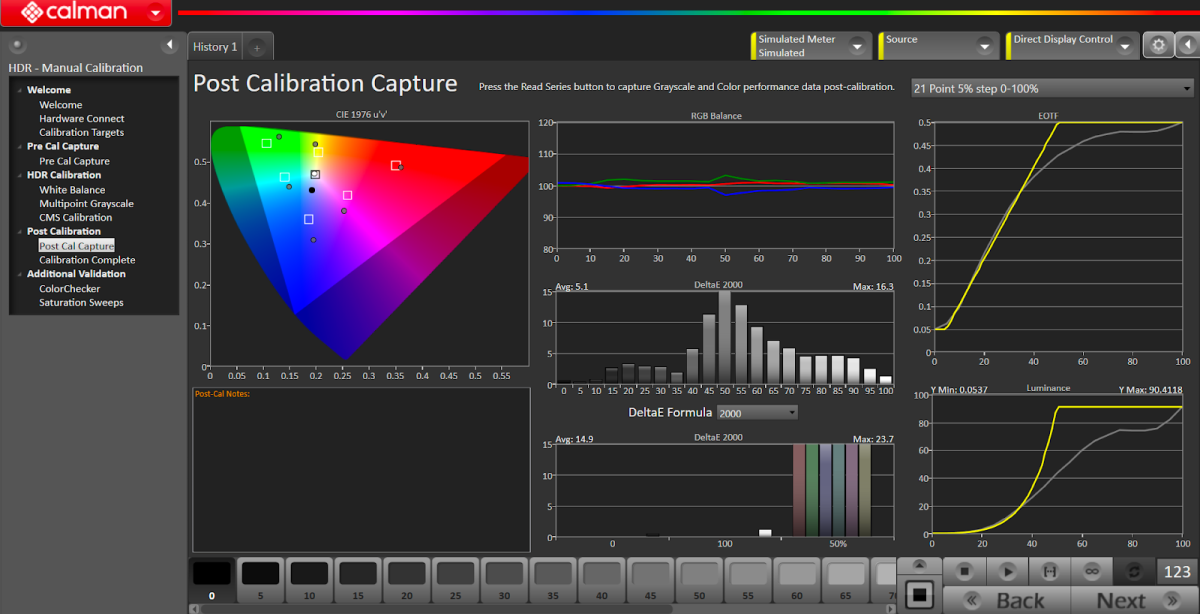
SDR
SDR mode is much like the HDR mode in viewing experience. The image is nice and detailed with good shadow details and depth it the low end, despite a relatively high black floor. This belies the fact that when looking at the calibration chart numbers and as the boss likes to say, “dots in boxes”, they don’t line up with that us calibrators prefer and call “reference”. As I said previously, I think they take this approach on purpose to give these USTs a certain look when they are being used in an ambient light environment like living rooms.
Most SDR content, even today, is still at HD resolutions like 720p or 1080p, but the Aura does a great job of upscaling this to its “faux K”, near 4K resolution with its pixel shifting techniques. It is a clean and detailed image without many of the scaling artifacts found in lesser devices. To go along with the good processing, the XGimi Arua’s on screen motion appears very natural with a smooth presentation at 60Hz.
I see the same tint/hue in SDR as I did with HDR, as I think this is just inherent in their optical engine design. It doesn’t look “bad” in any real sense, just different as compared to other full BT2020 RGB laser USTs and even some single laser DLP USTs like the BenQ V7050i. Maybe they use a different color wheel, phosphor wheel?
I did all the calibration and settings in the Custom mode. I think the hues are attributed to the cyan, blue and magenta being shifted and the combination of green towards cyan and yellow towards green shift combination all creates this specific look. If they had a CMS we could nail this down, but at this price point and value that omission may be understandable, considering the quality of the lens they’ve appeared to use, which eats into some of their engineering budget I am sure.

Pictures/Videos
Motion Handling
Focus/Sharpness

ANSI Contrast (We do not measure this on USTs)

Geometric Correction/Warping/H & V Keystone

Color Gamut Sweeps

Menu Interface


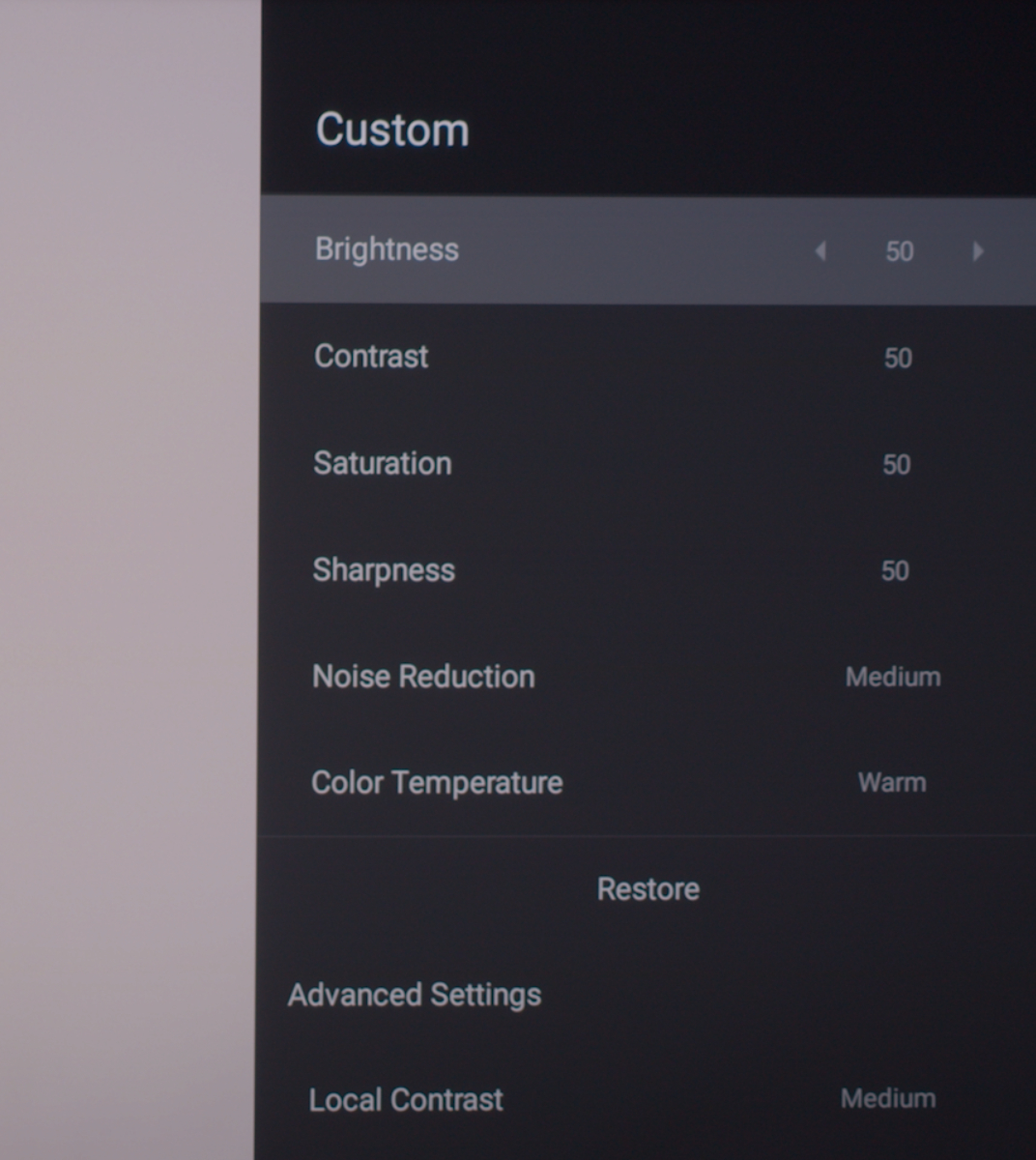
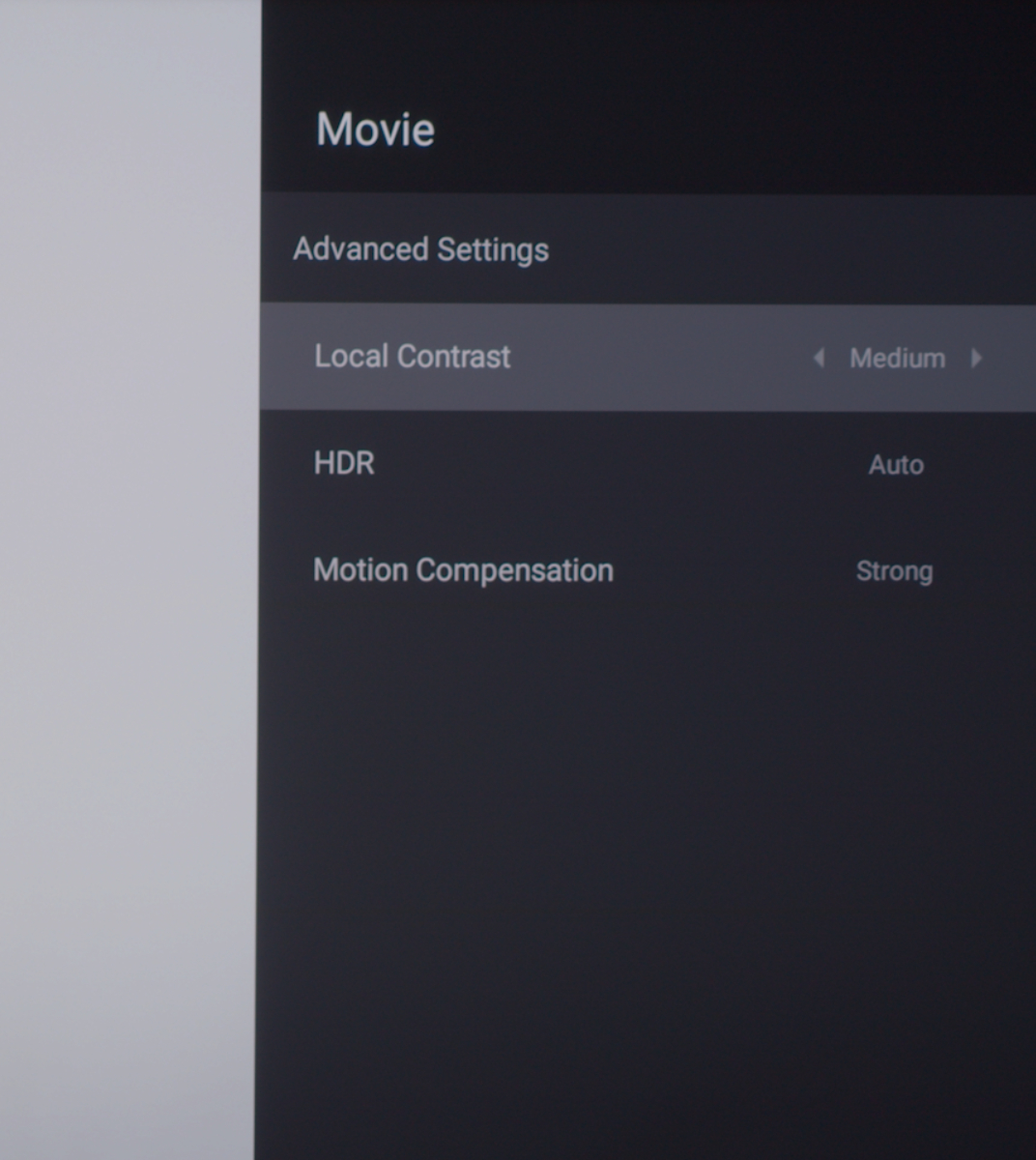





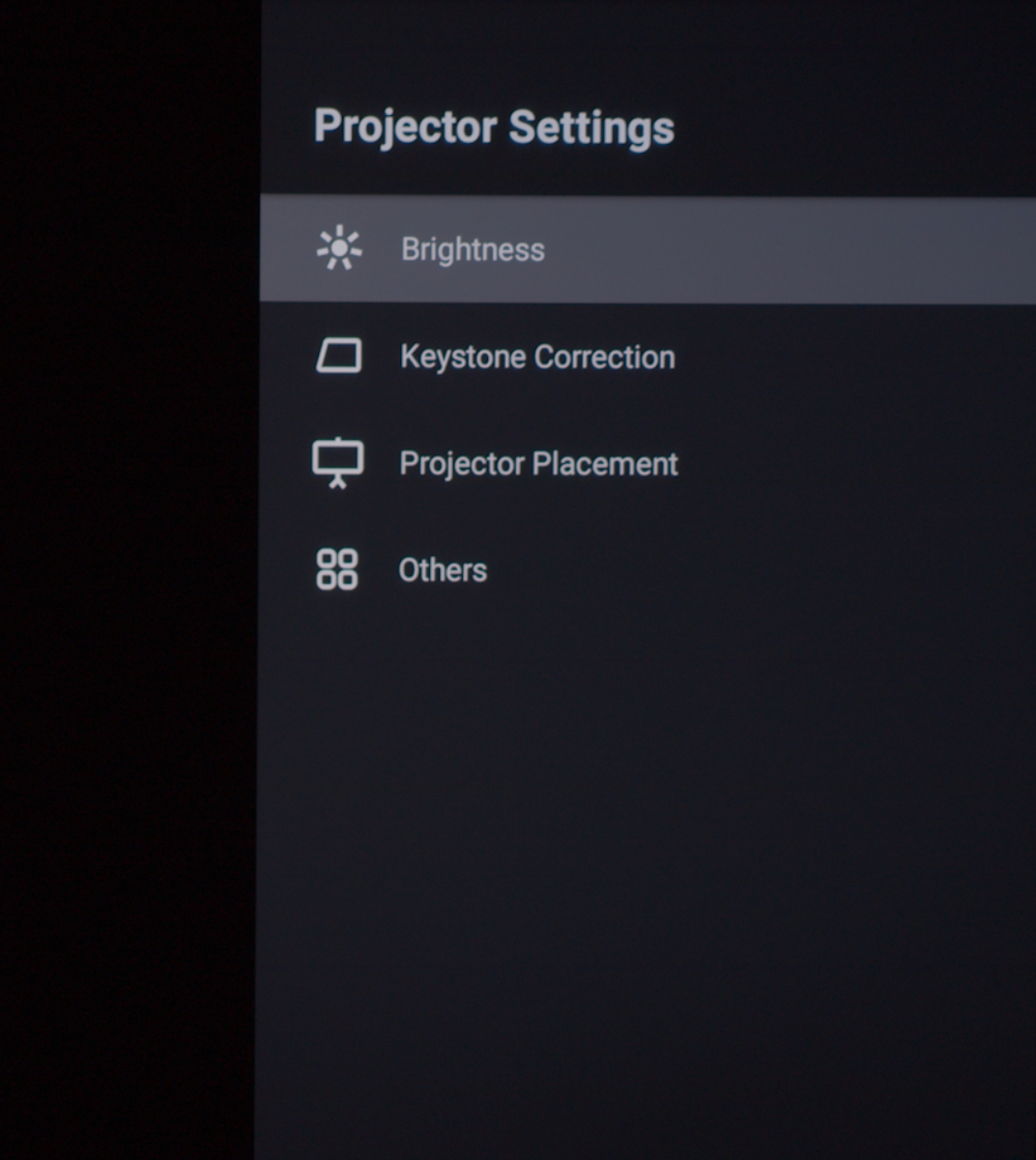


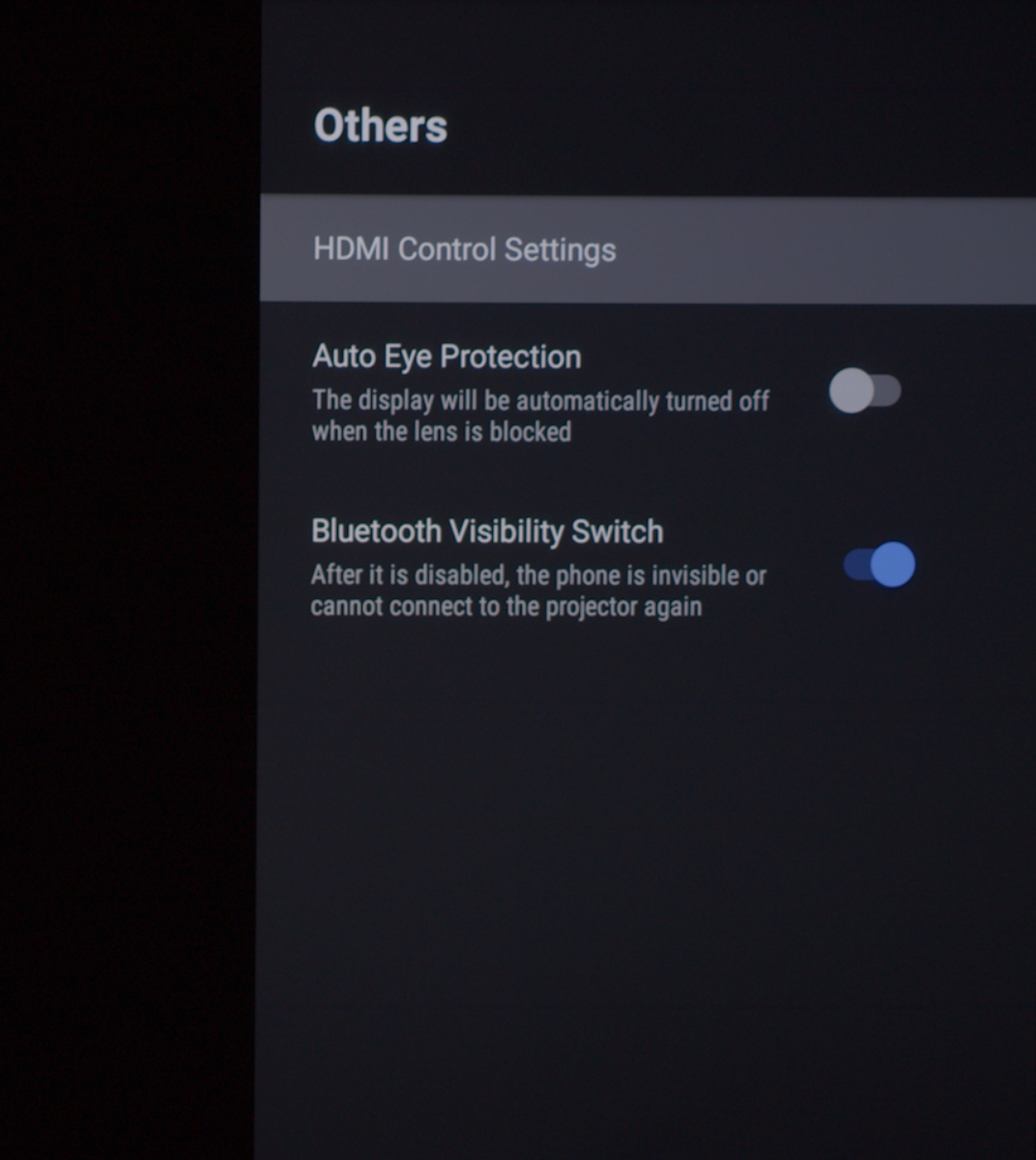


Picture Modes
SDR
There are 5 modes you can use on this projector called MOVIE, FOOTBALL, OFFICE, GAME and CUSTOM. Due to such limited picture settings there’s only 2 of the 5 I would even consider using, and they are the GAME and CUSTOM Modes because they’re the only ones with any semblance of settings to attempt to get an accurate and reference image on your screen. I settled on Custom as it appeared to have the best starting and ending points when calibrating to get closest to my goal. You could do both modes if you’re an avid gamer so that you have one mode like Custom for TV and movie watching and then switch over to Game Mode for playing the latest or your favorite video games, giving you the best lag times and latency.
Movie mode looks nothing like what you’d expect and get from most other displays and projectors and doesn’t differ too much at all from the other modes out of the box, and the other modes are immediately dismissed because they offer absolutely no settings options, so I would avoid those unless you just happen to like the image the way it is out of the box. Again these choices seem to have been made based on the use case for these types of USTs, to give peak image brightness for their intended environment. If you’re looking for easy modes to choose after cracking open the box and placing it on your credenza that get you close to standard images based on the modes and their naming conventions, you won’t really get it here, but with a little patience and use of the Custom Mode, you can get it close to what you desire despite the limited settings available.
In the Custom mode with the small amount of adjustments, I was surprisingly able to get the end result fairly close to a D65 reference and the color points of the gamut weren’t as far off as I have seen from other worse performing displays! The single point adjustment that is available is just barely enough to get close to what is needed, but it is serviceable and better than nothing here. The worst part is not having any gamma controls to speak of so tracking is all over the place, but this also appears intentional to boost the lows and midranges so they’re visible in high ambient light conditions, which the below 2.0 gamma that is measured seems to bear out. This makes this projector probably not the best choice for darker, more dedicated home theater type spaces, unless you like this look of course.
Summary
The XGIMI Aura, being a single blue laser with yellow phosphor, has muted and undersaturated colors, which do not reach full DCI-P3 or even full BT709. This is viewable in normal scenes, where it shows strange colors at times. You have to lower the blue and green a lot to get good white balance, which lowers the overall brightness. It seems this projector could benefit from something like Brilliant Color Technology that other DLPs utilize.
This projector features good contrast for this class of DLP, very good in fact. It measured at over 2,200:1 and it appears even higher in normal viewing. This gives the image a very deep and detailed image that looks very sharp without being too over enhanced digitally.
One noticeable issue is with gamma. No matter the mode, it is nowhere near 2.2 or 2.4 linearly across the range. As you can see on the Gamma charts above, it takes a nose dive in the middle and then goes back to the line at 100%. The gamma is very peaked and the levels are too high in the midranges, falling off the bottom of the chart. The best I saw when calibrating was a 1.73 gamma at 60%. This results in shadows and midrange content being way too bright and over exaggerated, looking unnatural with no way to correct this. I believe this is done intentionally to help overcome ambient light, which these USTs are designed to be used in as a TV replacement. So a gamma adjustment menu setting is greatly needed if you want to get accurate images when watching movies in the dark.
The menu options and settings are way too few and not enough to get a reference image from. Since the settings are shared between SDR and HDR, and the best and most comprehensive mode to use is Custom so you have some sort of brightness, contrast type user controls along with at least a simple single point white balance, it is near impossible to render both signals with complete accuracy. I think they should include the same settings for all modes, at minimum, so you can at least start with the mode’s baseline it gives you and then be able to adjust it from that point.
On follow on models, XGIMI may also want to consider using a color wheel with color segments closer to UHDA/DCI-P3 specs, or maybe at least add some sort of Brilliant Color technology, or better yet, go to a dual or tri-laser light engine as many other USTs are doing.
In this price range now, there are better options you can buy such as the recently reviewed Formovie Theater UST which has an RGB triple laser light engine with near BT2020 color gamut coverage and even better contrast and menu controls to tweak the image, such as a CMS (Color Management System) and full white balancing. An example of a single blue laser UST that is a better overall performer with better menu control options is the BenQ V7050i.



